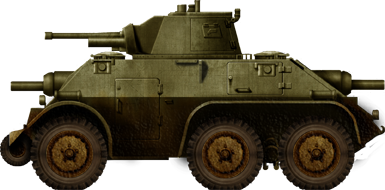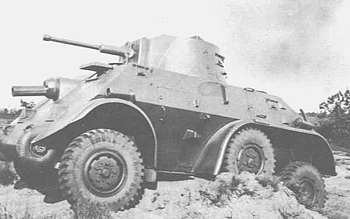Pantserwagen M39
 Armored car (1939) Kingdom of the Netherlands
Armored car (1939) Kingdom of the Netherlands
12 built

First national armored car
By 1936, when a modernization & rearmament program of the Dutch Royal Forces was proposed, Chief of Staff Lieutenant-General Izaak H. Reijnders chose to acquire just 36 armored cars, less costly than tanks. At that time, only a few nearly obsolete ex-German Erhart E-V4 armored cars were still in service. Twelve modern Landsverk 181 has been bought to equip a squadron in 1938 (as M36), and a second batch was to be ordered during the same year. However the government had already decided to free itself from the dependency on foreign manufacturers by 1937 and turn to its national truck builder DAF instead. It was also envisioned, since 1935, to licence-built a British model, but DAF quickly proposed a design of its own.The Trado suspension design
Indeed, Hub van Doorne and captain engineer Piet van der Trappen had already been working since 1935 on several paper projects based on their revolutionary "trado" (Doorne+Trappen) chassis and suspension system. It was essentially a semi-independent leaf-spring bogie activating two front road wheels, easily connected to any standard truck chassis, and compatible with Kégresse track systems, greatly improving its off-road capabilities. The Trado III was commercially a success, a well-proven system that served as a base for the "Pantrado" (for Pantservagen+trado).The Pantrado-1 was a very long vehicle for trench-crossing, the Pantrado-2 a double-ended small 6x4 chassis intended for the first 1936 order, although rejected initially by the Commissie Pantserautomobielen, charged to chose the best candidate. However, Van der Trappen defended his project, published a study on the well-known Militaire Spectator, and ultimately the Army, reassured by the fact it would also use the licence-built Ford engines, and pressured by the government to favor national builders, finally modified its specification in November 1936, more suited for the next Pantrado-III.
The Pantrado III
These new specifications included a metric weight of 6.4 tons, 70 km/h (43.49 mph) max speed, with a power-to-weight ratio of around 15 hp/ton, dual drive, a main armament comprising a 37 or 40 mm gun (1.45-1.57 in) and three machine guns, plus full protection against small arms fire, with armor up to 10 mm (0.39 in). Eventually the half-track option or 6x6 chassis were the most favored features for the Dutch project. A prototype using boiler plates was built in the spring of 1937, but somewhat differed from the original specification. The half-track option was dropped in the process. The body was a welded monocoque with sloped armor and the prototype was first shown to the commission in April 1938, which in turn demanded it to be quickly equipped with the planned armament.At that time, the Swedish Landsverk turret was the most obvious choice for adoption, and tests were performed with a dummy turret and the required weight until September 1938 within the active North Brabant's 1st Eskadron Pantserwagens. It compared favorably to the Landsverk M36, even successfully negotiating trenches and many obstacles thanks to an extra pair of unditching rollers. By 9th September the design was accepted, but the order was submitted with several additional conditions. The suspension was required to be of the 6x6 front-wheel drive type, with bulletproof tires of the Cellastic cushion type and a Ford 125 hp Lincoln-Zephir V8 engine, dual drive, improved differential and other details.
Production of the Pantserwagen M39
The order finally came in May 1939, with the first batch of 12 to be ready by September 1939. But because of the final assembly using the Swedish turrets, delivered by the Ordnance Department, was dependent on the Swedes, the intended figures shifted and delays rose due to many other supplier problems. The German Bosch electric system & French prismatic episcopes deliveries were slowed down or halted in September 1939. The machine-gun mounts were not even drawn on paper and later casting was proven impossible.Worst, following the Venlo incident the production line was evacuated from Eindhoven to Rotterdam, fearing a German invasion. In November the turrets were ready, but not the guns, as the Ordnance decided to produce the intended 37 mm under licence, which caused further delays. The army grew impatient, DAF subsequently reduced the unit cost to 1500 guilders and found local suppliers, Nederlandsche Instrumenten Compagnie (Nedisco) for the episcopes and Michelin for the bullet-proof tires. It was promised the first six would be ready in March 1940. However, these were finally delivered with normal tires, and cracks in the hull were discovered caused by an untested welding technique. The Comissie Pantserautomobielen urgently asked DAF to replace them.
Fate: The battle of Holland
In January 1940 the 4th Regiment Huzaren was planned to be the first equipped with the new model, followed by the 1st Regiment Huzaren and 2nd Regiment Huzaren, respectively based at Deventer, Amersfoort and Breda. However, only training was supposed to take place, until the units were fit for operations in 1941. The delays altered these plans, and by November 1939 the task to train crews was hastily given to the newly formed Cavalry Depot relocated at The Hague. In the end, due to postponed deliveries, the unit commander in charge of the four cavalry squadrons had to form his crews with two obsolete makeshift armored cars used during the great depression, and a handful of Carden Loyd tankettes detached from the defense of the Waalhaven airfield. When Fall Blau started, on 10th May, 1940, four vehicles were completed, parked in DAF factory Eindhoven, eight were stationed at Delft, defending the sector between the seat of the government, The Hague and Rotterdam.Two saw action on the 11th of May to support depot companies on the road to Rotterdam, unsuccessfully blocking the German advance. Another saw action at Delft and another helped to suppress the last pocket of German paras on 14th May at Overschie. The five available at The Hague were transferred to the Commander Fortress Holland and remained there, patrolling the streets fearing action form a supposedly fifth column and prevent Germans paras actions. However, on the 14th of May Commander Henri Winkelman ordered the remaining vehicles to be sabotaged and some were driven into the sea at Scheveningen. The four at DAF Factory were supposed to join the 4e Compagnie Korps Motordienst, but never made it. Lacking crews and ammunition, they were abandoned en route to Zealand on 13-14 May.
In German service
Since German units were in dire need of armored cars, captured ones were welcomed and a handful of repaired and overhauled M39's saw service with reconnaissance units as the Panzerspähwagen DAF 201 (h)9, painted in the standard Dunkelgrau, and sporting large Balkankreuz. The design had attracted the attention of the Waffenamt, but they nevertheless never attempted to resume the production. There are allegations that some M39 were used by German reconnaissance troops during the invasion of France, at least four were handed over to the Army Group "North" and used extensively throughout the summer and autumn of 1941, seeing action during the siege of Leningrad. Eight other captures were used in training units until 1943 and then disposed of. None survived to this day and the much improved M40 postwar production project for service in the Far East was postponed and finally abandoned.Links about the DAF M39
On Wikipedia (very exhaustive)Pantserwagen M39 specifications |
|
| Dimensions | 4.75x2.08x2.16 m (15.58x6.82x7.08 ft) |
| Total weight, battle ready : | 6 tons |
| Crew | 5 (commander/loader, 2 drivers, 2 gunners) |
| Propulsion | Ford Mercury V8, 95hp |
| Speed | 75 km/h (47 mph) |
| Operational Range | 200 km/85 liters (124.27 mi) |
| Armament | 37mm Mod 1939 Bofors gun (1.45 in) 3 x mod Lewis 7,65 mm machine guns (0.30 in) |
| Armor | 10 mm (0.39 in) |
| Total production | 12 + 1 prototype |

DAF M39 at Overschie, May 14, 1940, dealing with German paratroopers.
9.png)
Panzerspähwagen DAF 201 (h)9 in German service (Beutepanzer), 227th infantry division, November 1941, Northern Front. The wooden planks added to the rear mudguards were used for unditching.
Gallery

DAF 39 on trials. (Credits - landswerkm38.nl)

Pantrado III chassis, Credits - Wikimedia Commons
9.jpg)
Panzerspähwagen DAF 201(h)9 Credits - www.panzernet.net

Trado all terrain suspension Credits - Wikimedia Commons

WW2 Tanks




























WW2 tanks posters

All Tiger tanks liveries.

Panther liveries and variants

WW2 Armour - All tanks











Tanks aces and single tanks series

Find more there

Museums, Movies, Books & Games
The Tanks and Armor in pop culture
Tanks and armored vehicles in general are only really grasped when seen first person: The mass, the scale, it's all there. Explore also the way tanks were covered in the movie industry, in books and in video games.Movies:
Best tanks movie on warhistoryonline.com
On imdb.com
On bestsimilar.com/
miltours.com
liveabout.com/
watchmojo.com
Video Games:
pcgamesn.com
historyhit.com
levvvel.com
vg247.com/best-tank-games
mmobomb.com/
alienwarearena.com
